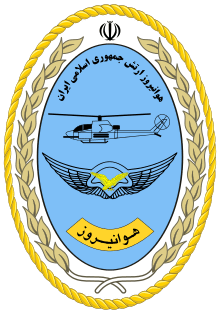Islamic Republic of Iran Army Aviation
| Islamic Republic of Iran Army Aviation | |
|---|---|
 Official seal of Islamic Republic of Iran Army Aviation | |
| Active |
1962–1979 (as Imperial Iranian Army Aviation) |
| Country | Iran |
| Branch | Islamic Republic of Iran Army |
| Type | Army aviation |
| Role | Tactical air transport, assault duties, anti-tank warfare, reconnaissance, special operations, liaison, disaster relief, firefighting, MEDEVAC, and CSAR |
| Nickname | Havanirooz (هوانیروز) |
| Anniversaries | 7 December |
| Engagements |
Dhofar war 1979 Kurdish rebellion in Iran Iran-Iraq War |
| Flying hours | 800,000 (1979–2011) |
| Commanders | |
| Current commander | Hooshang Yari (2011–present) |
| Notable commanders |
Manoochehr Khosrodad (?–1979) Kiyoomars Ahadi (2003–2011) |
Islamic Republic of Iran Army Aviation (IRIAA) (in Persian: هواپیمایی نیروی زمینی جمهوری اسلامی ایران), more commonly known as Havanirooz (هوانیروز),[1] is the army aviation of the Iranian Army.
Havanirooz members have the same rank insignia and titles as the rest of the Army.
Along with its primary military role, the Army Aviation is also involved in humanitarian aid missions, emergency relief, medical evacuations and forest firefighting.
History
Imperial Iranian Army Aviation

The core of the force was established in 1962 as the Imperial Iranian Army Aviation (IIAA) during the Pahlavi era as part of the Imperial Iranian Army with 6 Cessna 180 (U-17) aircraft and 6 pilots based in Isfahan. Meanwhile, officers were sent to the United States to be trained. The number of aircraft was 30 by 1966. In that year, 17 Kaman HH-43B Huskie helicopters were purchased from the United States. Iran also received 12 Cessna O-2As (which still can fly but are out of service). In 1971, the unit was expanded from an Aviation Battalion into an Aviation Regiment, with the purchase of Agusta-Bell 205 (AB-205A Iroquois) and 206 (AB-206 JetRanger) helicopters from Italy. Officers being sent to Italy for the related flight and technical courses. The Cessnas were phased out of service as the 205s became operational.

In 1973, a group of American advisors arrived in Iran to assess the geography and climate of the country, and it was decided to establish three combat units in Kermanshah, Masjed Soleyman, and Kerman, and one general support unit, in Isfahan, and a pilot and technical education center at Vatanpour Airbase; a total number of 202 Bell AH-1J Internationals (62 of which were TOW-capable) and 287 Bell 214A/C Isfahan helicopters were purchased from the United States, and American trainers were stationed at the Isfahan and Kermanshah education centers. Army Aviation was supposed to have become fully operational by 1982; however, the project was interrupted by the 1979 Revolution.[2][3] Iran has also delivered 70 Boeing (Elicotteri Meridionali) CH-47C Chinooks and 11 more after the Revolution from Italy.[2]
Imperial Iranian Army Aviation was one of the Iranian forces that participated in Dhofar war in Oman.
1979 Revolution
After the 1979 Revolution, then-commander of the Imperial Iranian Army Aviation Manoochehr Khosrodad was executed; he was also the founder and former commander of the 23rd Airborne Special Forces Brigade.
The force, which is now called Islamic Republic of Iran Army Aviation, participated in the post-Revolution clashes with the Kurds in Kermanshah (such as in breaking the Siege of Paveh) and Kordestan provinces.
Iran–Iraq war
IRIAA was heavily engaged in the Iran–Iraq war, with an average of 100 hours recorded flight per day overall during the war.[4] During the initial months of the war, the Army Aviation, usually operating on its own and using intelligence from local people, managed to stop Iraqi tanks from further advamcing into the western territories of Iran. This was being done usually using units consisted of AH-1J SeaCobras and a Bell 206 JetRanger. Between the Iranians, the SeaCobras gained a reputation as good as the F-14 Tomcats and F-4 Phantom IIs.
The Iran–Iraq War is the only war in history with confirmed "dogfights" between helicopters; in particular, between the American-built AH-1J SeaCobras (often the TOW-capable ones) of Iran and the Soviet-built Mil Mi-24 Hinds and the French-built Aérospatiale Gazelles of Iraq. The Mi-24 is stronger and faster, while the SeaCobras are more agile. The result of the skirmishes is disputed. Iran has also claimed to have downed an Iraqi MiG-21 using a SeaCobra.
Due to the post-Revolution weapons sanctions, Iran has had to make do with what was at hand; for example they equipped the International AH-1Js with the AGM-65 Maverick missiles and used it with some success. About half of the SeaCobras were lost during the conflict from combat, accidents, and simple wear and tear.[3]
Ahmad Keshvari and Ali Akbar Shiroodi were two prominent pilots of the IRIAA, both of whom were killed in the Iran–Iraq war. December 7, the date of Ahmad Keshvari's death, is the "Havanirooz Day" in Iranian Military calendar, and has been proposed by Iranian Army to be submitted in official Iranian calendar.[5]
Contemporary
From 1979 to 2011, more than 800,000 flight hours have been logged by the Havanirooz.[6] Thus, many of the helicopters delivered before the Revolution need to be repaired and refurbished, the Iranian Helicopter Support and Renewal Company (IHSRC; also known ad PANHA or Panha) has been founded for this purpose. Iran Aircraft Manufacturing Industrial Company (HESA) is also manufacturing new helicopters, usually based on those that Iran already has in its arsenal.
Organization
- Iran Aviation Industries Organization (IAIO)
- Iran Aircraft Manufacturing Industrial Company (HESA)
- Iranian Helicopter Support and Renewal Company (IHSRC, also known as PANHA)
Inventory
References
- ↑ Also transliterated as Havānīrūz, Havaniruz, Havanirooz, and Hava-Nirooz.
- ↑ 2.0 2.1 http://irartesh.ir/post/502
- ↑ 3.0 3.1 http://www.airvectors.net/avcobra_2.html
- ↑ http://www.pcparsi.com/%D8%A8%D8%A7%D9%84%DA%AF%D8%B1%D8%AF%D9%87%D8%A7%DB%8C-%DA%A9%D8%A8%D8%B1%D8%A7%DB%8C-%D9%87%D9%88%D8%A7%D9%86%DB%8C%D8%B1%D9%88%D8%B2-%D8%A7%D8%B1%D8%AA%D8%B4-%D8%B9%DA%A9%D8%B3--46660.html
- ↑ http://www.mehrnews.com/news/1759900/%D9%86%D8%A7%D9%85%DA%AF%D8%B0%D8%A7%D8%B1%DB%8C-15-%D8%A2%D8%B0%D8%B1-%D8%AF%D8%B1-%D8%AA%D9%82%D9%88%DB%8C%D9%85-%DA%A9%D8%B4%D9%88%D8%B1%DB%8C-%D8%A8%D9%87-%D8%B1%D9%88%D8%B2-%D8%B4%D9%87%DB%8C%D8%AF-%DA%A9%D8%B4%D9%88%D8%B1%DB%8C
- ↑ http://www.bultannews.com/fa/news/45102/%D9%87%D9%88%D8%A7%D9%86%DB%8C%D8%B1%D9%88%D8%B2-%D9%82%D8%AF%D8%B1%D8%AA%D9%85%D9%86%D8%AF-%D8%A7%DB%8C%D8%B1%D8%A7%D9%86
- http://www.aja.ir/Portal/Home/ShowPage.aspx?Object=News&CategoryID=b8789b0b-9886-4e12-94fb-8ecaaa0f102e&WebPartID=dec2520c-2881-448a-a61c-15883a9d5fd8&ID=5d611f2d-8daa-4dc8-9542-f2296d86e3b9
- http://www.magiran.com/npview.asp?ID=2273803
External links
| Wikimedia Commons has media related to Havanirooz. |
- IRIAA videos in Aparat
- IRIAA photo gallery in official website of Iranian Army